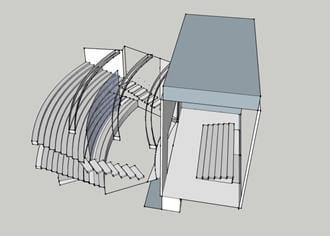Case Study: Creative Buildings that work
The demands on arts buildings include a host of community activities that bring them to life in many ways. In addition to pure performance there can also be mini-festivals, children’s holiday events, weddings, family celebrations, and conferences. All these are now part of the working life of an active arts building.
Meeting the needs of diverse markets is an important part of pre-planning for new or upgrading existing facilities.
These complex sites are at their best when the final design process is informed by a rigorous pre-design-informing process.
Value for money, savings on future operating costs and creating the best possible experience for a venue’s many audiences is at the heart of the work of two leaders in this field: Graham Walne and Andy Farrant.
Focus on value for money began when Graham and Andy discussed the many design errors that are literally cast in concrete in arts spaces and venues around Australia. To call them errors is polite because they directly impact on the effectiveness of the building and importantly the amount it costs to run each year.
To meet this challenge the Risk Informed Decision Making (RIDM) matrix was created to inform better decision making before any design work is started. RIDM draws on the building users – existing and potential, the project champion who sees a better community outcome, the building owner who will pay the operating costs each year and of course the audiences.
The objective: arts buildings where audiences can see the whole event, where sound and acoustics are at their optimum, where people-circulation means that the bar has strong sales, where people find comfortable places to sit and mingle and where people want to return again and again.
RIDM aims to avoid the repetition of common problems and where great design is informed by a rigorous process that delivers best value for money.
Meanwhile, here are five common drawbacks in venue planning and design.
- “Don’t you just face the seats in the same direction?” An architect’s question that demonstrated that he was unsure what theatre consultants actually did. While most architects have sat in a venue, very few have worked in one. Yes, the seats do (usually) face the same direction but arts buildings are complicated. Recently a very experienced building contractor admitted to us that the venue he had built was more complicated than any other building he had done, including hospitals. The reality is that most people beginning a venue plan and design are doing it for the first time, typically such people “don’t know, what they don’t know”.
- “It’s only a regional venue”. This was actually said to us by a senior public servant when the parameters for a new regional venue were being determined. He could not understand why the design team and the users simply wanted the best we could get. We knew that the reality is that some compromises will be inevitable, but vigilance is needed to ensure what is left is still the best, no matter where the building is.
- “If we cut the contingency it will be on budget” – A phrase actually used when the concept design had been first costed but the initial budget not been informed by any experience. In the absence of any additional funding, cutting the contingency seemed the only way to keep it affordable. Clearly this is a horse and cart issue. A vital component of RIDM includes an element of client engagement and education. This project was eventually completed but looked like not being usable because the deleted contingency budget initially meant that there was no furniture, lighting or sound equipment in the building.
- “You’re going down” A slow motion air crash. In air crashes rarely is the accident the result of one mistake. Generally a series of events occur which individually, are not serious, but when simultaneous,
the aircraft can no longer fly. Failures in the design of arts buildings can have similar consequences, particularly multipurpose ones where there is no clear function then nothing really works. Simple is better. - “The budget is a tool, not a sedative”. The more the bottom line is manipulated to look good (and to make those upstairs feel good) then the more it will come back to haunt you. Budgets need to be accurate, realistic and transparent, they need to have an organic nature to reflect changing circumstances. They also need to be regularly tested against benchmarks.
RIDM was created following a study of planning strategies that are used by different industries. The result is a matrix that works for refurbished and new projects. RIDM provides a pre-design process that leads to the completion of an informed and clear design brief for the architect to begin work. It also then drives project advancement so that the right decision makers attend the relevant meetings and new contractors are fully briefed on the project’s quality, objectives and client’s needs. RIDM combines these disciplines and puts them into an arts context.
When venues are planned and equipped there will be inevitable trade-offs in spaces, budgets and facilities, but Risk Informed Decision Making provides feedback loops to minimise the compromises and significantly, test the future operating cost implications before they are cast in concrete.
The outcome: a better result for audiences, artists, the building owner and the professionals who work within it.
Visit Graham’s website to connect with him.

